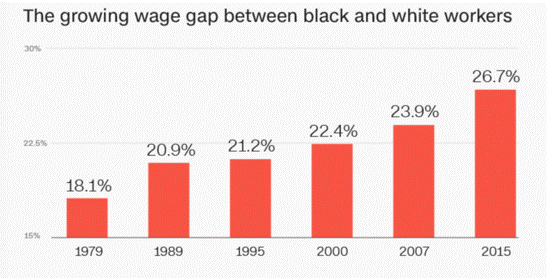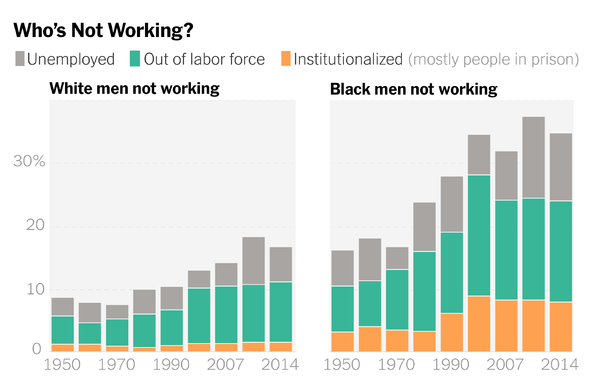|
Attribution: Current Population Survey - photo from Daily Kox, 1/28/17
David Leonhardt, writing in the June 25, 2020 NYT
One remarkable sign of the racial inequities plaguing the United States: The wage gap between black and white men is as large today as it was in 1950.
If you look at the government’s official wage statistics, you’ll see a somewhat different story. Those number show that the wage gap is smaller than in the mid-20th century.
But the official statistics are misleading. They exclude people who are not working — and there has been a sharp rise since the 1980s in the number of black men who don’t work.
Some have dropped out of the labor force, no longer looking for work after having failed to find decent-paying blue-collar jobs (a trend that has also hurt men of other races, though not as badly). Others are incarcerated. Over all, even before the recent economic downturn, about 30 percent of black men between the ages of 25 and 54 were not working, much more than in previous decades.
|
Attribution: Current Population Survey - photo from Daily Kox, 1/28/17
David Leonhardt, writing in the June 25, 2020 NYT
One remarkable sign of the racial inequities plaguing the United States: The wage gap between black and white men is as large today as it was in 1950.
If you look at the government’s official wage statistics, you’ll see a somewhat different story. Those number show that the wage gap is smaller than in the mid-20th century.
But the official statistics are misleading. They exclude people who are not working — and there has been a sharp rise since the 1980s in the number of black men who don’t work.
Some have dropped out of the labor force, no longer looking for work after having failed to find decent-paying blue-collar jobs (a trend that has also hurt men of other races, though not as badly). Others are incarcerated. Over all, even before the recent economic downturn, about 30 percent of black men between the ages of 25 and 54 were not working, much more than in previous decades.
|
|
|
As a result, the official statistics on wages and many other economic subjects ignore a growing segment of the black population. They cover only those men fortunate enough to be working. “It’s a weird hole,” Kerwin Kofi Charles, the dean of the Yale School of Management, told me.
When you take a comprehensive look at black and white men — as Charles and another economist, Patrick Bayer of Duke University, have done — you see that the black-white male wage gap is as large today as it was when Harry Truman was president. (I go into more detail, including charts, in this article.)
From The Magazine: “Racial income disparities today look no different than they did the decade before King’s March on Washington,” Nikole Hannah-Jones writes. “More critical, the racial wealth gap is about the same as it was in the 1950s as well. The typical black household today is poorer than 80 percent of white households.”
The central reason is centuries of government policies that have denied opportunities to black Americans — from slavery to the Homestead Act to Jim Crow laws to federally mandated segregation that affects housing prices today. The only solution, Hannah-Jones argues, is restitution: A federal program to repay black Americans for the wealth that the government has taken from them.
In her NYT article, regarding restitution, Hannah-Jones writes "The technical details, frankly, are the easier part. The real obstacle, the obstacle that we have never overcome, is garnering the political will — convincing enough Americans that the centuries-long forced economic disadvantage of black Americans should be remedied, that restitution is owed to people who have never had an equal chance to take advantage of the bounty they played such a significant part in creating".
The confluence of the COVID-19 pandemic and the racial justice movement in the U.S. is a unique opportunity to address generations of inequality, including those that are deeply imbedded in the nation's workforce. Available Staffing Network, minority owned and staffed, is in a singular position to help it's clients understand the issues surrounding the racial wage gap and help you in addressing it in your organization. If you would like to have this conversation, we would love to talk with you.
|
|
|

